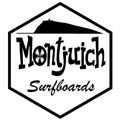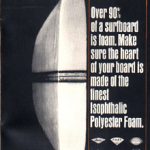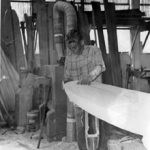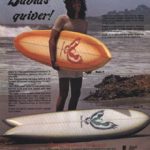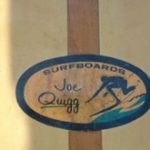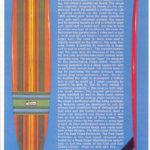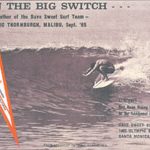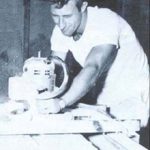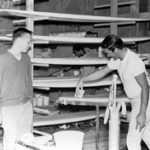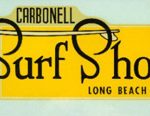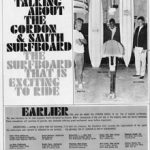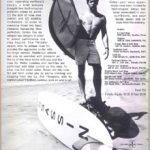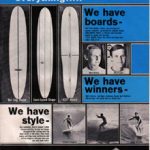Surfboard Labels from the 60s and 70s
This is a list of american surfboard labels that appeared until 1979.
Obviously this is not a definitive census. Corrections and additions will be very helpful.
– ACME: Fake sounding california label. Worked for the first half of the 60s.
Harbor City.
– (custom) ACUFF (surfboards): Early 60s.
– AIPA: Ben Aipa’s label. Hawaiian surfer and shaper. Pioneerer the design known as stinger. Mark Richards surfed his designs for years.
– A.J. (surfboards): Obscure California label from the early 60s. They offered balsa and foam shaping as an option. Prior to 1964.
– ALLEN (custom surfboards): From Long Beach (California). Another small label that appeared in 1962 aprox.
– (surfboards by) AQUA DIVERS: Lomita (California). Obscure label. Actually this was a scuba diver shop with some aquatic sports equipment, among them surfboards. Early 60s.
– AQUAJET: Shortboard transition label. At least they released a model called “Honeycomb”.
– ATLANTIC (surfboards): Despite the name it could be an west coast label. First half of the 60s.
– ATLANTIS GUNS: Early 70s. California label.
– (custom surfboards) AUSTIN-BAIRD: From Surfside (California). First half of the 60s.
– BAHNE (surfboards): Without being one of the big names of the industry, this firm enjoyed quite a following. In late 60s they introduced a Dick Brewer inspired model called “Crystal Ship”. La Jolla, California.
– BANZAI (surfboards): San Francisco, pre-1965.
– BENRAY: Pop out. Middle 60s.
– BENTON (custom surfboards): Early 60s.
– BERGESON: From the middle 60s.
– BILL: The company “Pacific Fiberglass”, directed by Bill May shaped boards at least since 1963. From Newport Beach (California).
– BILL WETZEL (surf forms): From San Clemente, California. 70s decade.
– BING (surfboards): One of the big names of the surfboard industry. Manhattan Beach local Herbert (Bing) Copeland was the barin behind this label. He learned how to shape from Dale Velzy. He was in close competition with Greg Noll Surfboards. He produced from the 60s decade until the early 70s. Very good quality boards. In the mid 60s he released two of the most popular boards ever made: the David Nuuhiwa noserider and the Pipeliner designed by Dick Brewer (Surfboards Hawaii’s exshaper).
Under the Bing name other models were released like the Donald Takayama model, a V-bottom model, the Karma model, the Pintail, the Foil, the Lotus… Not like other big labels, Bing could adapt the change of times until the early 70s. Anyway, after the commercial release of the Campbell brothers design called Bonzer, Copeland got into the commercial fishing business.
– (surfboards) BING & RICK: Before they split and starting their own workshops, Bing Copeland and Rick Stoner were partners in the balsa wood era.
– BLAKER (surfboards): First half of the 60s.
– BLUE CHEER (surfboards): From Santa Monica (California). Jay Stone founded this label. In 1970 it was working. California shaper Michel Junod worked for this firm.
– BOHEMIAN (surfboards): Classic example of an early 60s pop out label. The boards were made with a mold using cheap materials and then were laminated. Shaping was not involved in the process. This kind of board was made for the big market, addressed to an unexperienced customer. The stuff was sold in big department stores and generic sports shops. The shapes were kind of odd and the finishes were rough.
– (custom surfboards) BRAD: Manhattan Beach, California. Mid 60s.
– (surfboards by) BRAGG: Bill Bragg was the shaper. Early 60s. Located in Gardena (California).
– (custom) BUD GARDNER (surfboards): They released the “Gidget” model. From California, 1960s.
– BUNGER (surfboards): One of the pioneer labels from the east coast. At least they worked from 1963. New York.
– CALIFORNIA (surfboards): Steve Bernard was the shaper from this southern California label. They worked until the mid 60s. There was a company with the same name who made foam blanks, but I’m not sure if they are the same
– CAMPBELL: This is the label the Campbell brothers started to sell their bonzer design in early 70s.
– CANBERRA (surfboards): Paul Banasky shaped his boards in the mid 60s in Downey, California.
– CARBONELL (surfboards): From Long Beach, this label with a name of catalan origin was popular in the area. They got their “47” model. They lasted through all the 60s decade.
– (surfboards by) CASTER: From the 60s. I’m almost sure this had to be the label of Billy Caster, a shaper from San Diego county.
– CHALLENGER (surfboards): From Pacific Beach. This firm was owned by Bill Bahne and Frank McCleary. Shaper Carl West was another partner too. Early 60s.
In 1965, West went to the east coast and started Challenger Surfboards East.
– CHANNIN (surfboards): After splitting with “Diff”, Tony Channin started his own operation in 1970. His glass jobs were the best in the industry.
– CHANNIN/DIFFENDERFER (surfboards): Tony Chanin and Mike Diffenderfer worked together since 1965. In 1967 produced chambered balsa boards. The factory was located in Del Mar, California. The professional partnership lasted until 1970.
– CHAPMAN (surfboards): Dave Chapman started a surf shop in the same location that Don Hansen left when he went to Encinitas in the mid 60s. Just in front of Cardiff reef. Dave Chapman and Bob Turner were the shapers. Tony Chanin was the glasser.
– CHEETAH (surfboards): Label stablished by the same guys who did Matador-Collier Surfboards for satisfying the east coast demand in the midst of the 60s.
– CHOATE (surfboards): Dennis Choate shaped his own boards in Imperial Beach. From California, 60s decade.
– CHUCK DENT (surfboards): A popular brand from the 60s. From Huntington Beach. Operated since 1963 through 1970. The riders were Barry K., Mark Martinson and Billy Hamilton.
– (surfboards by) CHRISTENSON: First half of the 60s. San Diego.
– CLARK (foam products): Gordon Clark stop his partnership with Hobie Alter in the late 50s to concetrate in his foam blowing operation. He produced foams for the best brands of the industry, although he shared room with other foam producers as Walker, Foss and Greg Noll. From Laguna Beach.
– CLIFFORD-GEORGE (surfboards): Another California name. Fred Clifford was one of the brains behind this firm. Located in Santa Barbara. Early 60s.
– COLLIER (surfboards): Frank Collier was a wood craftsman who got in touch with the furutre founder of Matador Surfboards. Early 60s, California.
– CON (surfboards): Con Colburn began with his own operation in 1959. He opened a shop in Pico Boulevard, in the heart of Santa Monica.
His boards were quite popular in southern California. The label’s most innovative design was “the Ugly” noserider, ridden by Bob Purvey in several contests.
– CONTINENTAL (surfboards): Label created by the Matador-Collier Surfboards people to satisfy the east coast demand.
– (custom surfboards by) COPELAND’S: Located in Corpus Christi, Texas. Early 60s.
– COSMO: Seems like a California name from the 70s.
– COUNTRY (surfboards): Hawaiian brand from the 70s.
– COUNTRY HAWK (surfboards): From Leucadia, California. Early 70s.
– CRESCENT: Surfboards sold in the surf shop of the same name. California, early 60s.
– CRESTWOOD: 60s decade. Maybe from the east coast.
– CROW (surf board): From Surfside (California). Early 60s.
– CURCIO (surfboards): Label created by the Matador-Collier Surfboards people to satisfy the east coast demand.
– CUTLASS (surfboards): Pre-1965.
– (surfboards by) DALE: After having tax problems and lost the rights of his own name, Dale Velzy started a new label with different name in the early 60s. Never got the same popularity as in the 50s. It’s quite possible they released pop out boards under this name.
– DALE B. WOODISARD (surfboards): From Cardiff, California. Early 60s.
– DAVE SWEET (surfboards): Started shaping in 1948 and opened a shop in 1956. His efforts as a polyurethane foam blower pioneer were hidden in the surf media for years. He started messing with foam in 1952. The first foam boards were sold commercially in the late 50s, but weren’t as populars as the Hobie ones. Dave never wanted to go big so his production feed just the area of Santa Monica. Miki Dora got boards from Sweet as a team rider. Some Hollywood celebrities like Peter Lawford, Dick Van Dyke, Jack Lemmon and Clark Gable were usual customers. The shortboard revolution marked the end of this name.
– DAVID NUUHIWA (surfboards): Label that worked since early 70s in Huntington Beach. Fishes and other standard designs of the era were shaped.
– DC (del cannon surfboards): Del Cannon was a consistent surfer from La Jolla. In the mid 60s he shaped for Wardy. Years later he tried luck with his own operation. At least he worked until 1968.
– DELBY WOODWORTH: Actually this guy was a boat builder. During three or four years he made some surfboards. From Solana Beach, California. Mid 60s.
– DEMOTT (surfboards): From the 60s decade.
– (surfboards by) DEWEY WEBER: One of the big ones. Weber, after leaving his job as manager of the Velzy surf shop in Venice Beach opened his own operation in 1960. He was a great businessman, with a sophisticated merchandising. For a while, he got lots of benefits from the east coast market.
Dewey was not just a great shaper, he was a comitted surfer (some say he was the first hotdogger). The “Performer” model released in 1965 was one of the best sellers surfboard models from the sixties. 10.000 units were produced. He adapted to the new times, and in 1968 he signed Nat Young as a team rider. Also in the late 60s introduced the advanced design called the “Ski”. With the shaping anarchism of the early 70s, Dewey got a new job as a commercial fisher. Anyway he was crucial in reintroducing the board over nine feet in the early 80s.
– DEXTRA (surfboards): Maybe the most known pop out label of the era. This California name started in 1963 and lasted until 1969 as far as I know.
– DIVE’N’SURF: Maybe the first company to research in the wetsuit field. In 1960 they sold beaver tail type jackets. In 1965 the shortie with no sleeves was introduced. Located in Redondo Beach, California. The label evolved and eventually became Bodyglove in 1968.
– DIVER’S DEN: A wetsuit workshop for scuba diving. They sold jackets for surfers too. First half of the 60s, California.
– DIWAIN (surfboard co.): From Huntington Park, California.
– (surfboards by) DONALD TAKAYAMA: Surfer and shaper of great prestige. In the late 60s started his solo shaping career after working for the great names of the era.
– DOOLITTLE (surfboards): Located in Santa Clara (California). 60s decade.
– (surfboards by) DOUG ROTH: From Goleta (California). Early 60s.
– (surfboards by) DOYLE & MAJEK: Mid 60s. I ignore if the name Doyle is refering to Mike Doyle.
– DUCKS (custom surfboards): One of the pioneer east coast labels.
– DUKE DANA: From San Diego, and of course from the 60s.
– DUKE KAHANAMOUKU: First half of the 60s decade. Someone wanted to take advantage of the Duke’s name. Fred Hemmings, Butch Van Artsdalen, Joey Cabell and Paul Strauch endorsed this label. Not so sure if these boards got something to do with the Greg Noll factory.
There was so much product under the Duke’s name (skateboards, sneakers, clothes…) I think they produced some pop out surfboards too.
– (surfboards by) DUSTY RHODES: From Manhattan Beach (California), Mid to late 60s.
– DYNO: Early 70s. The fish concept was his trademark.
– (surfboards) EAST: As you might expect this is an east coast firm from the mid 60s.
– ENCINITAS (surfboards): Established by John Kies in 1975 in Encinitas, California.
– EKSTROM: A local surfer from La Jolla, in San Diego county who founded his own label. His most original concept was the assimetrical board for surfing left or right point breaks.
– (surfboards by) ERNIE TANAKA: Shaper who operated in California during the early 60s.
– FLAHERTY (surfboards): Tom Flaherty and Richard Massey sold their boards in a shop located in Canoga Park (California). Early 60s.
– FLYNG DUTCHMAN: Early 60s.
– FOSS (foam): The third foam producer in importance in the 60s. From Costa Mesa, California.
– FRED PIKE (Custom Built Surfboards): Early 60s.
– (surfboards by) FREEMAN: Early 60s and possibly from the east coast.
– GALT (custom): Early 60s.
– GEORGE DOWNING: Pioneer hawaiian big wave rider. Starting in the early 60s, standard boards and big wave guns were produced.
– GEMINI SURFBOARDS: Hawaiian label from the late 60s or early 70s.
– GOMES FIBERGLASSING: Allan Gomes worked as laminator and glasser for other firms from the late 50s. Workshop situated in Venice Beach (California).
– GORDIE (surfboards): Gordon Duane got his headquarters in Huntington Beach, starting in the surfboard business in the late 50s. He enjoyed a good following in the area. One of his famous models was the “Lizard” of 1967.
Very good craftsmanship and advanced designs for its time.
– GORDON & SMITH (surfboards): Very popular name in the San Diego area first and the whole California coast after. Larry Gordon and Floyd Smith shaped boards in the balsa era and then switched to foam. They got the most talented men in the workshop and in the waves: Mike Hynson (of the red fin model fame), Barry K., the controversial Butch Van Artsdalen, Skip Frye (with his own model in 1967), even the aussie stylish Midget Farrelly was among the G&S team for a while.
Some models: the “Hot Curl” from 1967, the 1962 “Quarter Speed”… G&S got an australian franchise in the mid 60s. They say they were the firsts to take advantage of the surf t-shirt concept.
– (custom surfboards by the) GREEK: Bob Bolen (of greek origins) started surfing in 1958, and the shaping thing came a little bit later.
In the middle of the model surfboard craze he released lots of different designs: “Concave” (1965), “Eliminator” (1966), “Liquidator” (1967), “Maui” (1967) and the “MacIntosh Apple” in 1968. Bob came along with the “Turbotunnel” fin concept in the late 90s.
– GREG NOLL (surfboards): A renaissance surf man. A real waterman: hot dogger, big wave rider, long distance paddler, editor, lifeguard, fisherman, surf film maker and a shaper of course.
He shaped balsa boards at the very beginning of the 50s decade. In 1953 his boards were sold in a serious way. He became one of the main characters of the south bay surf industry. He even started to blow his own foam in the Hermosa Beach factory. He specialised in curved stringer boards. In 1965 he opened the biggest surfboard factory in the industry. In 1966 the Miki Dora’s own model was released: the famous “Da Cat”. For the east coast surf fever a Gary Propper model was produced.
Although Noll introduced several interpretations of the shortboard concept –with the Johnny Fain model or the Seeker- at the beginning of the 70s he closed his factory to became a commercial fisher.
– (surfboards by) HACK: Early 60s.
– HALEY (surfboards): From Seal Beach, California. Early to mid 60s.
– HANG FIVE: From Huntington Beach. Early 1960s.
– HANNON (surfboards): In 1962 already existed this firm and it lasted until the 70s. From Florida.
– HANSEN (surfboards): Doug Hansen began with his label in 1961 in Cardiff, California. Among his riders and shapers he got the great Mike Doyle with several surfboard models with his name.
Other models were the “Competitor”, the “50/50”, the “Master”, the “Hustler” or the “Super Lite” in 1968. L.J. Richards also rode for Hansen as long as Encinitas local Rusty Miller and Linda Benson.
Hansen was one of the big names in the industry, being a clever businessman.
– HARBOUR (surfboards): Rich E. Harbour started as an amateur shaper in the late 50s. In 1962 his professional career began. His most famous models were the “Banana”, the “Cheater”, the “Trestle Special” or the “Rapier” from 1968.
From Seal Beach, California. Among his team riders were one of the first Pipeline masters: Jock Sutherland and not to forget Steve Bigler.
– HAUT (surfboards): Doug Haut was in charge of this label from Santa Cruz. 60s decade.
– (surfboards) HAWAII: A very popular hawaiian brand from the early 60s. John Price was the manager of the operation. They produced boards both in the islands as long as in Encinitas, California. A good choice for continent surfers looking for the right equipment for the North Shore. Buzzy Trent, Ricky Grigg, Billy Hamilton, Fred Van Dyke and Butch Van Artsdalen were common riders of this boards. The most celebrated shaper was Dick Brewer, but in 1966 left the label to go to Bing. Some models: the model “A” and the “Stylist”.
– HAWAIIAN: Roughly made surfboards from the first half of the 60s.
– HAWAIIAN VIBRATIONS (by Mark Foo): Late 70s. Some shapes were done by Mike Diffenderfer.
– (surfboards by) HAWK: Early 60s. East coast. Nothing to do with the Velzy nickname. In 1960 they produced boards.
– HEALTHWAYS: California label from the mid 60s.
– HERMOSA (surfboard): From Hermosa Beach, Cali. Sold exclusively at the The Outrigger shop.
– HOBIE (surfboards): Hobart “Hobie” Alter shaped his first board in 1950 in his garage of Laguna Beach. In 1954 opened a small shop in Dana Point. Hobie was who really made popular the polyurethane foam core surfboards since 1958 (known as easter eggs for its pastel color decoration). Many surfboard producers followed the steps of Hobie.
He was the first to sell a signature model, with the Phil Edwards one. Pioneer in selling skateboards too, in 1962. In the mid 60s a clothing line was released and at the end of the decade researched and released a catamaran concept known today as Hobie Cat. The east coast sales in the mid sixties overtook the California sales.
Lots of big names worked for the Hobie name like Corky Carroll, he was one of the first “pro-surfers” in the second half of the 60s (his board model was a best seller). Mickey Muñoz also worked for him.
Alter was one of the members of the “Dana Point Mafia”, a group of surf industry moguls who controlled the market. If Velzy was the pillar of the surf industry in the 50s, Alter along with Noll, Jacobs, Weber and Copeland did the same in the 60s.
– HOLDEN: William G. Holden produced boards in Costa Mesa. Since 1959 aprox.
– HOLMESY (surfboards): From Juno Beach, Florida. In 1967 worked at full gear.
– HOMETOWN (surfboards): Created by californian John Kies at the beginning of the 70s. Fifty boards were produced aprox.
– HYDRO: John Kelly designed a sophisticated hydrodynamic gun sold in a small scale operation. From Hawaii, 1963.
– HYNSON: In the 70s, Mike Hynson got their own surfboard operation working. He shaped guns and shortboards with psychedelic decorations.
– IKE (surfboards): Before Reynolds Yater was the most respected shaper in the Santa Barbara area, John E. Eichert ruled. Balsa baords from the late 50s. He later went with the foam change. His early cutaway fins were out of its time.
– INLAND (surfboards): 70s decade.
– INTER-ISLAND (surfboards): Mike Diffenderfer and Dick Brewer among others shaped for this brand. Reno Abellira, Kimo Hollinger, Conrad Cahna and other hawaiian stylish surfed these boards. The operation lasted all the 60s decade. From Hawaii.
– INTERNATIONAL (surfboards): Label created by the Matador-Collier Surfboards people to satisfy the east coast demand.
– ISLANDER (surfboards): 60s decade.
– JACK’S: Started in 1957. From Anaheim, California.
– JACOBS: After spliting with Dale Velzy, Hap Jacobs started his own workshop at the beginning of the 60s. The best of the best worked for him in the workshop or in the water. His most famous riders were Miki Dora and Lance Carson. The Jacobs boards from the early 60s were almost bullet proof, with double 10 oz lamination in deck and bottom. An early stinger design was introduced in 1965 with the “422” model.
Jacobs like many others got lost in the psychedelic days of weird shapes and became a commercial fisherman like other industry fellows.
– JEFF HO (surfboards & zephyr productions): Santa Mónica, 70s decade. Innovative designs and transgressor decorations. From Dogtown, of the Z-boys fame.
– (surfboards by) JEFFREY DALE: From Santa Ana, California. Started in 1963 aprox.
– JET BOARD: From the mid 60s. A jet propelled board with disatrous results in the water.
– JOE QUIGG: One of the fathers of the modern board. With Bob Simmons and Matt Kivlin did a lot of experimenting during the fities. At the end of the fifties he opened a workshop in Newport Beach. Later Quigg went to Hawaii and focused on catamaran building. In 1962, still worked in the surfboard industry.
– JOEY CABELL (custom surfboards): The talented hawaiian surfer got his own label. From mid to late 60s.
– KEOKI: Early 60s.
– KOAST (surfboards): California brand from the early 70s. John Kies was the shaper. From Leucadia. They closed in 1975.
– LANCE CARSON (surfboards): Carson shaped his old Jacobs noseriding model during the 70s.
– LANIKAI: Early 60s. Maybe pop out boards.
– LARI JAI: California, mid 60s.
– (surfboards by) LARRY FELKER: Felker built boards in his shop in Woodland Hills (Cali.), but for a time he was located in Hermosa Beach.
– LEE’S (surf boards): Early 60s.
– LEEDY: Early 60s. Costa Mesa, California.
– LIGHTNIN’ BOLT: The most famous logo of the 70s. Created by the Pipeline master himself, Gerry Lopez in 1972. These boards were the standard equipment for the North Shore. Everybody sighted for a Lightnin’ bolt.
– LISARDI (surfboards): Produced in Los Angeles in 1964, and later in 1966 in Hermosa Beach. They lasted until the transition days.
– LOE: In 1967 they were active.
– LYMAN (surfboards): Redondo Beach. From 1961 aprox.
– (surfboards) MAKAHA: From Honolulu. In 1965 they produced a good amount of boards.
– MAKO: Maybe a pop out. Pre 1964.
– MALIBU: Pop Out label. Early 60s. The shop was located in the Pacific Coast Highway.
– MANATEE (surfboards): Label created by the Matador-Collier Surfboards people to satisfy the east coast demand.
– MARLIN (surfboards): Early 60s.
– MATADOR (surfboards): Shaped from 1962 to 1968. From California.
– MAUI SURF SHOP: Hawaiian. Mid to late 60s.
– MICHEL JUNOD (customs): While Junod shaped for other hawaiian names, he got his own label too. Worked under this name from 1974 to 1978. Located in the South Shore of Oahu.
– (custom surfboards by) MILLER: From Daytona Beach, Florida.
– MILLIKEN (surfboards): From the L.A. suburb Whittier. Early 60s.
– MOONSHINE: From 70s decade.
– MOREY-POPE: Tom Morey and Karl Pope were ahead of their time. Their product was original and well done using new technologies and unusual concepts.
The bearded Bob Cooper rode for them with his signature model called “Blue Machine”. John Peck got his “Penetrator” model and even the aussie guru shaper Bob McTavish got his “Tracker” model.
They produced a susbtitue for surfboard wax called Slipcheck in 1968, and other surfboard gadgets. From Ventura, California. They close up the company at the entry of the 70s.
– MOREY TRISECT: Tom Morey produced in 1965 a board that could be mounted from three separate parts. The concept was good but not so efficient technically.
– (surfboards by) MOSELLE: Maybe one of those surfboards labels just made to endorse a surf shop. From Culver City (California). From 1959 to 1963.
– MT (surfboards): East coast surf star Mike Tabeling own label. 70s decade.
– M.T.B. (surfboards): Late 60s to early 70s. From California. The shaper was Donald Takayama.
– OAHU: Another label to endorse the surf shop of the same name. 60s decade.
– OCEANSIDE: From Florida. Late 60s. In 1967 they released the “Spoiler” model.
– OLE (custom surfboards): From Seal Beach, California. Property of Bob Olson who started shaping in 1958. Mickey Muñoz was involved with the firm as well. It lasted until the shortboard days.
– OLIN : Early 60s.
– OLYMPIC: From San Diego. Early 60s.
– O’NEILL: During the early part of the 60s decade, O’Neill produced his own boards as well as wetsuits. He released the “Intruder” model. He got rid of the surfboard thing when he focused in the wetsuit industry. Located in Santa Cruz, California.
– OWL: From Santa Barbara. Started in 1962 and ended production in the following decade. During the 70s, Phil Becker used to shape boards over the 9’ range. In 1980 Becker started his own company.
– PACIFIC: 1963 aprox. Del Mar, California.
– PACIFIC SYSTEM HOMES: Actually this was a carpentry company focused in wooden houses production.
During the 30s they manufactured solid wood boards. This was the first commercial company to build surfboards. The most popular model was the “Swastika”, the name was changed in the late 30s for obvious reasons. It was renamed “Waikiki”. They end production in the 40s.
– PAT CURREN (custom surfboards): One of the kings of Waimea and Makaha. Along with Bev Morgan (ex-business partner of Hap Jacobs) the great Pat Curren designed and shaped balsa guns. The most streamlined and gorgeous boards made for catching big hawaiian waves.
– PAUL HUNT: From southern California. His boards were sold in a couple of surf shops.
– PECKS BEACH (surfboards): Label created by the Matador-Collier Surfboards people to satisfy the east coast demand.
– PETRILLO (surfboards): Late 60s.
– (surfboards by) PHIL: Low quality boards from Downey, suburb from Los Angeles. Phil Sauers got his Hollywood contacts, so there’s lots of beach party movies from 1963 to 1966 you can see Phil’s surfboards. Even in the 1964 movie “Ride the wild surf”, the name got an important cameo.
– (surfboards by) PHIL EDWARDS: Around 1967, Edwards left Hobie to shape his own idea of functional board fro high performance surfing. Good quality boards with knife like rails, and sophisticated fins. Lasted until the end of the decade. Located in Honolulu.
– PHILLIPS: Jim Phillips started his own label in 1965 in the east coast. Some years later he went to stay in California.
– PISMO BEACH SURF SHOP: This surf shop sold boards under hits own name. Mid 60s.
– PLASTIC FANTASTIC (surfboards): Early 70s. Jock Sutherland was a team rider for a while. Huntington Beach, California.
– POMEROY: From California, early 60s.
– PROGRESSIVE EXPRESIONS: Hawaiian label born in 1970. The originator was glasser/shaper Joe Kuala, after working for Inter-island and Surboards Makaha.
– QUIET FLIGHT: 70s decade.
– RAINBOW: Early 70s. Mike Hynson was involved. Known for their psychedelic decorations.
– RAMSEY JAY: Newport Beach, California. Middle 60s.
– (surfboards shaped by) RANDY RARICK: This surfer started to shine in the late 60s, later started to shape boards in Sunset Beach, Hawaii.
– RICHMARK: California. 70s decade.
– RICK: A popular name of the 60s. Rick Stoner was the Bing Copeland ex-partner. His most famous model was the “UFO”. Other models were the “Barry K. Pintail” and the “Dru Harrison Improvisor”.
– ROBERT AUGUST: He was shaping in an independent way through all the 70s decade.
– ROBERT SHEPPARD: Big wave rider who shaped some balsa boards around 1957.
– ROBERTS: Robert F. Millner, opened a surf shop in Playa del Rey (California). Early 60s.
– ROBERTSON – SWEET: The most bizarre association from a surfboard firm.
They tried to build foam core surfboard out of a mold with no shaping involved in 1960, when foam boards were in their origins.
The co-star of “Gidget” (the movie responsible of the surf massification) Cliff Robertson decided to invest in this operation in a way to catch in the surf boom. Dave Sweet’s Brother was the other partner. The boards never went so good and the label eventually died. Joe Quigg worked for them as a technician consultant.
– (custom) ROD (laguna): Maybe from Laguna Beach (California). Early 60s.
– ROSSER: Southern California, early 60s.
– ROYAL HAWAIIAN: Pre 1965.
– SAFARI (surfboards): Boards sold at the “Pacific Craft Products” shop in Santa Fe Springs, California. Mid 60s.
– SCHUCK (custom surfboards): From Trenton, New Jersey. Early 60s.
– SCOFIELD (surfboards): Label from Santa Cruz, California. Early 60s.
– SEA CROSS (surfboards): From Burbank, California. Pre-1965.
– SEA SUITS: Pioneered the making of wetsuits. Middle of the 60s.
– SHANG: Shannon McCrary was the shaper. From Coronado, California. Early 60s.
– SHARK: The same factory who produced the “Ten Toes” and “Tiki” surfboards, also made this mediocre boards.
– SHOALL (surfboards): From Harbor City and Hermosa Beach (California). Mid 60s.
– SHULER: 70s decade.
– SINCOR: Early 60s. From Venice Beach, California.
– SKAG: Early 60s. From Hermosa Beach, California.
– SKIP FRYE: He shaped freelance from time to time. Shaped boards over the 9 feet range with streamlined pin tailed shapes and later his name was related to the fish concept.
– SOUTH COAST (surfboards): Southern California. Pat Curren shaped on accasion for them. The noserider model named “Tip Rider” was introduced in 1966.
– SPORTFLITE: Maybe a Pop-Out label. From California. Mid 60s.
– STEVE WALDEN: 70s decade.
– STING RAY: California, pre-1965.
– SUNSHINE (surfboards): Late 60s. They released a Claude Codgen model.
– SURF BOARD HOUSE: More sixties product.
– SURF LINE (surfboards): From Honolulu. Gerry Lopez got employed in this company.
– SURF RESEARCH: Main surf wax manufacturer from California. Mid 60s.
– SURF WAX: From Redondo Beach, California. Produced surf wax in the late 60s.
– SURFCO: Maybe they were pop out boards, so they were sold in a scuba diving shop in San Diego, and in the company central located in L.A.. The owner was Hoppy Swarts, one of the surf pioneers of California. 1963 aprox.
– SURFING’S NEW IMAGE: 70s decade.
– SOUTH BAY (by Titan): From Los Angeles area. Pop out boards. Early 60s.
– SWEENY: Early 60s.
– TAMARACK BOARDS: California label wich operated from the mid sixties until the late part of the decade.
– TEN TOES: Pop out boards. Produced by the company “Pacific Plastics” in Ventura. 1963 aprox.
– TIKI: The “Pacific Plastics” company another time doing the pop out thing.
– TILTON-SULTZEN (surfboards): From Santa Cruz (California). Second half of the 60s.
– TRAVIS: Travis Ashbrock was the shaper. Workshop located at the Pacific Coast Highway. California, 1963.
– TUCKER: Balboa Island, California. Early 60s.
– VAGABOND (custom surfboards): California. Early 60s.
– VARDEMAN (surfboards): The workshop was situated in Long Beach, but the surf shop was in Hermosa Beach. A medium size surfboard label.
Sonny Vardeman, was a surfer who started in the balsa era as a shaper.
– (surfboards by) VELZY : Legendary name. The origin of the surf industry can be related to this name. Another waterman and colorful character: surfer, shaper, cowboy, hot rodder, biker, sailor… Dale Velzy began shaping in the late 40s and became “the biggest surfboard builder in the world” like the ads said. He teamed up with Hap Jacobs. First one to have team riders. ALL the big surfing names passed through the Velzy shops doors. Dewey Weber was one of his pupils.
Velzy didn’t declare nothing. He always got a stack of dollar bills in his pocket, but the government realised of that and they took everything Velzy got. In the late 50s he was ruined.
– VELZY (surf board): Pop out boards under the Dale Velzy name in order to make a quick buck.
– (surf boards by) VELZY & JACOBS: Dale Velzy and Hap Jacobs were partners for a number of years. They got their “pig” design working and got popular among the south bay surfers.
– (custom surfboards by) VENTURA SURF SHOP: From Ventura, 1963.
– WALKER: After Clark Foam, Walker was the other big foam producer. The factory was situated in San Clemente.
– WARDY (surfboards): Frederick Wardy was the shaper. From Laguna Beach, 60s decade.
– WAVEMASTER (surfboards): Label created by the Matador-Collier Surfboards people to satisfy the east coast demand.
– WAYNE: California label. Mid 60s.
– (surfboards by) WESTCOAST: From Ocenaside, California. Early 60s.
– WEST WINDS (surfboards): Michel Junod’s first try to shape alone. Santa Cruz, early 70s until 1974.
– WILDERNESS (surfboards): Started in 1964. The shaper was Michael Cundith, who adopted the kneeboard designs of genius George Greenough for stand up surf. Santa Bárbara, California.
– WILKEN (surfboards): From Santa Monica. Miki Dora sued the label to get some profit after a magazine ad in wich appear his name with no permission. Late 60s.
– WILLIAM DENNIS: Late 60s. Bob Cooper made some design for them.
– WINDANSEA (surfboards): From Newport Beach, California. Mid to late 60s.
– WISE (surfboards): From San Francisco. Mid 60s.
– (surfboards by) YATER: Another great California shaper. From Santa Barbara.
At the beginning, the boards wore the label “Santa Barbara Surf Shop”, but after some time came the most popular “surfboards by Yater”. His shapes used to get
working in the breaks of Rincon Point. He came with the “spoon” concept later used in the stepdeck craze.
– (surfboards by) YOUNT: From Santa Cruz (California). Early 60s.
– ZUMA JAY (surfboards): From Malibu. Founded in 1976.
Written by Didac Piquer Puigdemont.
©Copyright de Didac Piquer Puigdemont

